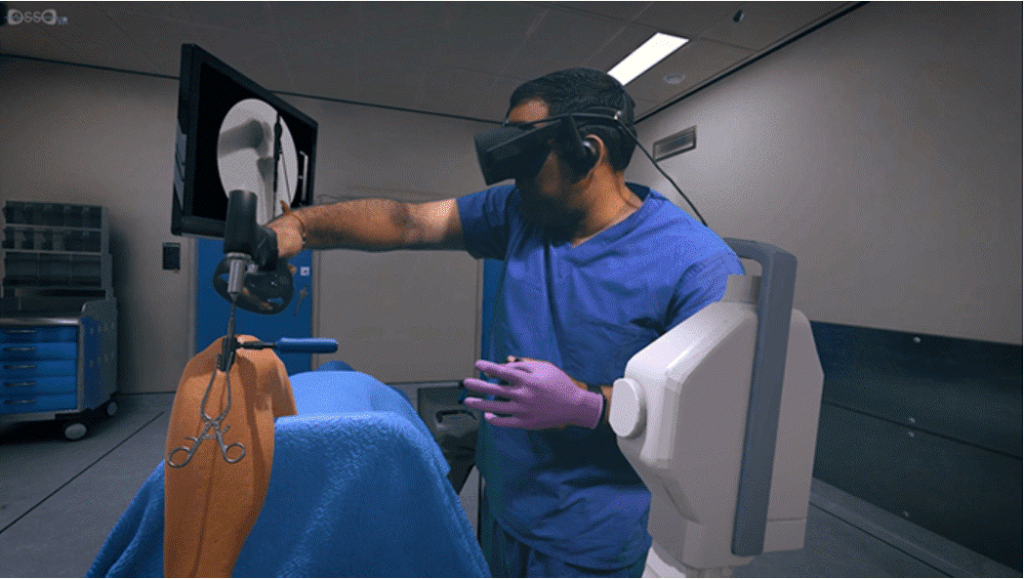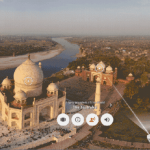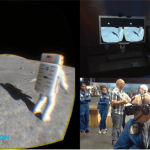Why Using VR Technology for Learning?
Education is the base for a thriving society, and the transfer of knowledge has been a top priority for civilizations since the very beginning. People are constantly looking for ways to make knowledge transfer more easily, more quickly, and more effectively. In the era of digital devices, we have an opportunity to enable better learning with technology. Virtual Reality (VR) seems to be the natural next step for the evolution of education.
How We Learn Today
Before diving into the details of how VR in education will help improve the learning process, it’s important to understand why we need to improve the quality of education in the first place. Historically, most technologies designed to aid learning have been aimed at enabling access to information — facts and observations about the world. Before computers, we had a powerful tool that helped us retain facts: books.
In the era of digital technologies, books are being turned into eBooks. Modern search engines make fact-finding really easy — with just a few clicks you can discover answers to many questions. While knowledge has become more easily available for more people, the current approach to education has two significant problems:
- It’s based on the same old format — fact retention.Teaching methods are focused on providing facts; however, having access to and consuming a lot of information isn’t learning. Being informed isn’t the same as being educated.
- A lot of people have difficulties comprehending information. Too much information received in a short period of time can easily overwhelm students. As a result, they become bored, disengaged, and usually not sure why they are learning about a topic in the first place.
With VR, they aren’t limited to word descriptions or book illustrations.
They can explore the topic and see how things are put together.
What makes VR in Edication Beneficial?
Virtual reality can be used to enhance student learning and engagement. VR education can transform the way educational content is delivered; it works on the premise of creating a virtual world — real or imagined — and allows users not only see it but also interact with it. Being immersed in what you’re learning motivates you to fully understand it. It’ll require less cognitive load to process the information. Here are just a few properties that makes virtual reality in education so powerful.
Better sense of place
When students read about something, they often want to experience it. With VR, they aren’t limited to word descriptions or book illustrations; they can explore the topic and see how things are put together. Thanks to the feeling of presence VR provides, students can learn about a subject by living it. It’s easy to forget that VR experiences aren’t real — a body actually believes it’s in a new place. This feeling engages the mind in a way that is remarkable.


Scale learning experiences
Technologies such as science labs are amazing — they allow students to understand how things work based on practical experience.
A relatively small VR device can even act as a whole science lab
But such technologies are expensive and almost impossible to scale. They are also limited in the number of things they can do.
Learn by doing
It’s a well-known fact that people learn best by doing; however, if you inspect modern education, you’ll see how little learning actually happens by doing. Students are focused on reading instructions rather than using them in practice.
VR in education provides an experience anchor to the instruction. With VR education, learners are inspired to discover for themselves. Students have an opportunity to learn by doing rather than passively reading


Emotional reaction
Visceral reactions to what we are experiencing are fundamental to forming memories. VR in education makes it easy to engage students the whole time, making experiences memorable.
Develop creativity
Having virtual reality in education is useful not only for content consumption, but it’s also great for content creation. By giving students powerful tools such as Tilt Brush, you help them boost their creativity.
Visual learning
A lot of people are visual learners — VR is really helpful for this group of learners. Instead of reading about things, students actually see the things they’re learning about. Being able to visualize complex functions or mechanisms makes them easier to comprehend.
Users are ready to embrace new technology
The first idea that pops into anyone’s mind when they think about VR technology is an entertainment experience. Many designers see VR as an extension of the gaming industry. It’s true that VR has historically been dedicated to gaming, but things are changing. According to a recent survey conducted by Greenlight VR, desire for education outweighs desire for gaming content — 63.9 percent vs. 61 percent. Categories of VR educational experiences Where can we apply virtual reality in education? The answer is almost everywhere. VR creates an infinite set of possibilities that people can experience. Here are few types of experiences you can create with VR.
I never teach my pupils, I only attempt to provide the conditions in which they can learn — Albert Einstein
Virtual fields trips
VR technology can be used to engage students in topics related to geography, history, or literature by offering a deeply immersive senses of place and time. Simply imagine geography lessons where you can visit any place on the globe — this type of experience is much more enriching than just reading about it.
Google Expeditions is one good example of an app designed to provide such an experience. Expedition is a library of field trips available for regular smartphone users. Each trip is comprised of VR panoramas, and trips vary from the Great Wall of China to Mars. People all over the world can visit places that are virtually impossible to visit in person.
Google piloted this app in hundreds of schools all over the world. The project was extremely successful, with Google taking more than 1 million students in 11 countries on expeditions.
Of course, virtual reality will never replace real field trips and travels, nor should it. But, VR enables experiences to happen that would be otherwise impossible.


High Tech Training
VR is a good solution for highly technical training fields like the military or the medical industry. For example, the most significant challenge for medical students learning anatomy is understanding the body in three dimensions and how different systems fit together. VR education can help overcome this problem.
One good example is the VR system used by Mendel Grammar School in Opava City, Czech Republic, which helps students in biology classes learn about the anatomy of the eye. The team working on this project employed a Leap Motion controller and specially-¬adapted Oculus Rift headsets to provide an innovative way of learning anatomy.


Internships
Getting exposure to different careers is an essential part of the learning process. From early childhood, we dream about what we want to be when we grow up, and those dreams are usually inspired by the professionals in our lives. Often, we get this understanding through internships.
Another benefit of having virtual reality in education is its ability to help broaden students’ exposure to careers. It improves people’s ability to imagine themselves in others’ shoes. Career expeditions show what it’s like to work in a field — students can explore a day in someone’s career, see what person is studying, and understand what a person likes — or doesn’t like — about their job. As a result, the experience becomes familiar to students.
Group learning
Some of the most important knowledge we gain doesn’t come from what we hear from lecturers, but rather from collegiality and debate. VR education gives the opportunity to make learning experiences social by allowing students to communicate with each other. Using avatars and mapped facial expressions, people can come together to discuss, synthesize, and learn from one another.
Distance learning
VR allows us to bridge the gap between educators and learners. With VR, distance learning tools can put educators and students together in the same room with digital representations of themselves — teachers can teleport into the VR world and guide students through their experiences.
Design challenges for VR education experiences
Clearly, the future of virtual reality in education is very exciting and full of potential. We are just at the dawn of this powerful technology and designing for VR is full of challenges that we should be ready to overcome.
5 key properties of good VR learning experiences VR education apps should have the following properties:
01
Immersive. Designers should strive to create the feeling that users are in an experience. For example, if you develop a history app, make history come alive for students.
02
Easy to use. Eliminate the need to have special skills to interact with a VR app.
03
Meaningful. Meaning is really important for students. You can’t create a good VR learning experience without a good story. That’s why it so important to advance the art of storytelling. Stories quite simply provide the best vehicle for delivering messages that are not only heard and understood, but that also inspire and elicit action.
04
Adaptable. As Albert Einstein once said, “I never teach my pupils, I only attempt to provide the conditions in which they can learn.” VR experiences should allow students to explore at their own pace. The app should provide complete control over the level of difficulty. Designers should establish how students learn and then use this knowledge to design VR products that allow effective learning
05
Measurable. Each educational tool should provide measured impact. Teachers should be able to track the metrics of education so they can measure the resulting knowledge of a subject. When designing experiences for VR education, it’s essential to choose appropriate metrics and make it clear what criterium will be used to measure success and failure.
Creating a new role for teachers with VR education
The transition from analog teaching practices to digital ones is going to change what teaching looks like. The role of a teacher will change from content delivery to content facilitation. Teachers will be focused on creating conditions for exploring, rather than providing ready-made knowledge.
Our changing understanding of immersive experiences
It’s clear we’re in the early stages of VR — and it’s going to keep changing. However, technology will continue to push boundaries of how immersive VR can become. We’re even going to see advancements in eye tracking and body tracking in coming years. What we consider an immersive experience today will be considered table stakes in the not-too-distant future.
Making VR accessible
VR has a high price point that is a significant barrier for many users. If we analyze the success of Google Expeditions, it’s clear that Google was able to reach this many students because the hardware was really accessible. To make VR education accessible to a majority of users, it’s important to focus on creating VR experiences for devices users already have and repurpose them into powerful tools for education. A phone we have in our pockets and $20-100 headset devices — such as Google Cardboard or Samsung Gear VR — should be enough to give students good VR experiences.

